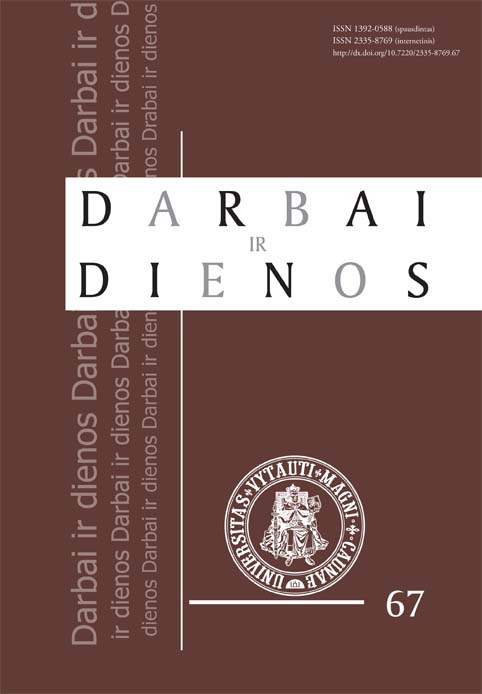„Die Russen in Ostpreussen“: Rusijos ir rusų įvaizdžiai 1914–1939 m. Vokietijoje publikuotuose atsiminimuose apie Didįjį karą Rytų Prūsijoje
“Die Russen in Ostpreussen“: Images of Russia and Russians in the Memoirs on the Great War in East Prussia, Published in Germany from 1914 to 1939
Author(s): Hektoras VitkusSubject(s): History, Military history, Political history, Pre-WW I & WW I (1900 -1919)
Published by: Vytauto Didžiojo Universitetas
Keywords: East Prussia; Russia; Great War; Memoirs; Images;
Summary/Abstract: The paper aims to analyze the formation of the images of Russia and Russians in East Prussia in the years of the Great War and the continuity of those images in the interwar period in Germany, based on memoirs published between 1914 and 1939. This was done by (a) an analysis of the preconditions for the genesis of stereotypes, images, and myths (mythologemes) of Russia and the Russian “invasion” of East Prussia from the viewpoint of the psychology of war and the archetype theory, and (b) studies of the frame and content of the most typical images, stereotypes, and mythologemes of the Russian “invasion” in the memoirs reflecting on the Great War events in East Prussia, published in Germany in the interwar period. The studies led to the following conclusions.First, due to the approaches of the archetype theory and the psychology of war, it becomes evident that the stereotypes, images, and mythemes formed in the discourse of the Germany-published memoirs, testimonies, and reminiscence-based essays with regard to Russia and Russians functioned not merely as an important “East Prussian” stage of the Great War-myth-creation element, but also as an ontological enemy concept principle. Thus, between August 1914 and April 1915, in the period of active fighting on East Prussian territory, the images of Russia and Russians were an integral part of war propaganda, intended to psychologically mobilize groups of the Eastern Prussian population against the invasion of the “enemy.” In the period from 1916 to 1918, this trend of incorporating the “East Prussian” Great War experience into the content of the images of Russia and Russians declined due to a lessening in preferences for those images. As military action moved to the former territory of the Russian Empire, the German memoirs of that period caused narratives related to the German Kulturarbeit (cultural activities) in the East to be actualized. However, in the years from 1919 to 1932, the images of Russia and the Russian “invasion” were again included in the memories of the Great War in East Prussia, remaining relevant to the Great War myths formed in the Weimar Republic. The images were relevant also due to the activity of war victim and veteran organizations which provided those images with group war experiences. Ultimately, in the period from 1933 to 1939, they were subjected to the “Eastern myth,” ideologically escalated by the National Socialist regime, and the conception of Ostforschung (East Research) which served the NAZI propaganda purposes. Second, even though in general the images of the “Russian invasion” and the “flood of Russians” in the memoirs published in Germany retained a negative content, they underwent transformations both at the macro (political and cultural) and micro (social and domestic) levels. At the macro level, the Great War experience-based image of Russia developed on the understanding of “the global threat of Russia to the civilized world”. At the micro-level, the image of Russia rested on the experiences undergone by war participants and civilians coming in contact with Russians in East Prussia in the period of the Great War. At the latter level, the stereotypes, images, and myths were predetermined by such factors as the intensity of the war actions and different patterns of behavior exhibited by Russian army units in different localities of the East Prussian province. Therefore, irrespective of the prevalence of essentially negative concepts of the “Russian invasion” in that set of images, certain alternative evaluations existed that created the prerequisites for the evaluation of Russians from the viewpoint of moral attitudes focusing on humanity. Nevertheless, the total image of Russia’s invasion of East Prussia did not experience any major changes and remained categorically negative. The trend was preconditioned both by the aspirations of the German political elite and the ideological conjuncture in which the memory of the Great War was one of the most significant elements. The experience of the “Russian invasion” of East Prussia was a particularly meaningful factor which provided political forces, affecting different communities of memories, with great manipulation opportunities. Suffice it to say that one of the most significant components in the remembrance of the Great War in the interwar period was the Tannenberg Memorial, directly related to the grand narrative of the victory against the Russians in 1914 and the liberation of East Prussia. Thus, in the German discourse of the interwar period, Russia and Russians became firmly established in an image of a “conquered enemy.” Efforts were made to maintain the image throughout the interwar years, and particularly during the period of the National Socialist dominance. Psychologically, the experience of the “Russian invasion” of East Prussia allowed one to see Russia and Russians as an “easily conquerable enemy”: the conception of Russia/Soviet Union as a “colossus with feet of clay,” used by Adolf Hitler and other National Socialist leaders, was as though a paraphrase of the concept used as early as the Great War.
Journal: Darbai ir dienos
- Issue Year: 2017
- Issue No: 67
- Page Range: 31-67
- Page Count: 37
- Language: Lithuanian

